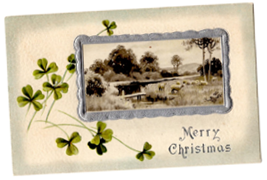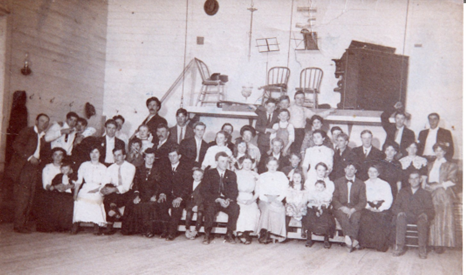Administrator’s Notes
Ralph Gibson, Museums Administrator
 |
Ralph Jr. and Russell sledding, February 1932. May Perry Collection, Placer County Museums. |
From all our staff, I wish each of you a very Merry Christmas and a Happy New Year!
Christmas Card Confusion
Kasia Woroniecka, Curator of Collections
There are many Christmas cards in our collection, but among them are a few that don’t seem Christmassy at all. In the 19th century the iconography of Christmas was not fully developed and some of the images depicted on the cards had nothing to do with Christmas, winter, or the season at all.Christmas was not a holiday in early America, and it wasn’t until the 19th century that Americans began to embrace and reinvent it from a carnival holiday to a family-centered day of peace, charity and good-will. Christmas was declared a federal holiday in 1870, so before that it was up to the employers to give their workers a day off to celebrate with their families.
The printing of the first Christmas card in 1843 was commissioned by Sir Henry Cole, English educator and first director of the Victoria and Albert Museum in London. Yet it wasn’t until the 1860s when the commercial printing of postcards, influenced by technical improvements to the printing process and mass production of images, took off. Victorians collected, displayed, and mailed cards in great numbers, and standardized mail and delivery prices contributed to postcard popularity.
 |
Christmas greeting card with a pastoral view and clover. 1908. Placer County Museums Collection. |
 |
Christmas greeting card with pink roses. C. 1900. Placer County Museums Collection |
The following postcards are from an album (1959.7.2). They are glued to the pages, so messages, stamps, or publication dates are not available. The album was donated by Lucy Thomas of Weimar.
 |
Christmas greeting cards. Children with dog. C. 1880. Placer County Museums Collection. |


 |
Christmas greeting card. Putti with spring flowers and swallow. C. 1900. Placer County Museums Collection. |
 |
Christmas greeting card. Forest scene with deer and elves C. 1910. Placer County Museums Collection. |
Christmas in the Mines
April McDonald-Loomis, Placer County Historical Society
Most diaries recorded Christmas almost in passing, instead chronicling the day to day drudgery of mining, the weather, and daily chores like cooking and laundry. James Staples, who was mining near Auburn on December 25, 1851, wrote only about the miserable weather and building a coffin for a dear friend. Dr. Stillman, in Sacramento in 1849, wrote: “There is nothing here to remind me of Christmas.”
Sometimes the diaries and letters did record Christmas celebrations. Louis Amelia Smith wrote from the Feather River in 1851 of a Christmas when the local saloon had a new owner and “casks of brandy and baskets of champagne” began arriving via mule train. She noted that it was the first time the wooden floors of the saloon had ever been scrubbed. That celebration lasted a whole three weeks! Whether due to celebrating the holiday or the presence of a large supply of liquor for the grand opening of the saloon is unclear.
Many of the celebrations around Christmas on the East coast centered around food, lavish spreads that could take days to prepare. In the gold camps food played an important part of the celebrations also. One diarist wrote they were treated to “flapjacks fried in bacon grease, bootleg coffee, and Johnny cakes that were baked on a shovel.” Another reported that “they feasted on flapjacks, biscuits baked with a little gunpowder for added flavor, and for a rare dessert: a can of peaches.”
The weather and local of the miners was also a factor. There are several accounts of men trapped in the deep snow of the Sierras with little food and less joy. The closer to a town, the easier to get something special for the holiday.
Another thing common in the accounts was dancing. Many miners arrived with small portable instruments like violins, flutes, banjos, guitars, clarinets and accordions. Men showed little reluctance to take the female part in the dancing, wearing an arm band or ribbon to denote their role.
 |
SUNDAY MORNING IN THE MINES, 1872. Charles Christian Nahl . Crocker Art Museum, E. B. Crocker Collection, 1872.381. |
Shooting off guns or making small explosive devices was also a common thread. One miner wrote, “ there were guns, pistols, and rifles popping off all around us. We blew up 2 or 3 old glass bottles.”
Nostalgia and homesickness often was evident in the diaries and letters. The men expressed a longing for family and friends. One young miner even admitted that on Christmas day he “hid himself behind some bushes , sat down and cried, and thought about home and wished he was there.” He did feel better later surrounded by his fellow miners sitting around the fire telling stories and singing Christmas songs.
Many historians have written about the general lack of moral restraint felt by the young miners out from under the all-seeing eye of the village townsfolks and their families. “There was a tendency toward various indulgences and men more readily engaged in questionable, riotous behavior.”
By 1852, with the arrival of more women and children, the social fabric of the mining camps began to change. The women brought religion, moral judgement and education. Men began to moderate their behavior and limit the excesses previously enjoyed. Christmas became a “more like a settled familiar Eastern pattern of a family -centered, private day of celebration. One miner wrote: "With families came a sense of home life, and the general recklessness that had been a marked feature in the early days was beginning to disappear.”
This article replied heavily on the Master of Arts thesis by Christian Parker, Christmas During the California Gold Rush, 2008. CSU-Csus.esplor.exlibirsgroup.com
The Guy Who is Santa Claus
Christina Richter, Administrative Clerk, Archives & Collections
Sun editor Francis P. Church explained to Virginia “Without Santa there would be no childlike faith, then, no poetry, no romance to make tolerable this existence. He exists as certainly as love and generosity and devotion exist.” Perhaps the most poignant phrase is “Nobody can conceive or imagine all the wonders …unseen and unseeable in the world.”
The city of Auburn is especially fortunate to have had a legendary Santa Claus for over a quarter of a century. His name was Guy Lukens.
Sylvester Guy Lukens, aka “Guy”, became involved in his community at an early age. At the age of 20 he was one of the organizers of the ‘new’ volunteer Auburn Fire Department and two years later he was elected Chief of Auburn Hook and Ladder Co. No 1, taking the position January 1, 1905. He treasured this post and eventually became the oldest volunteer Fire Chief in the state. Lukens once explained that in the early days “what we lacked in equipment we made up for in enthusiasm.”
Guy was also appointed, then elected, as Placer County’s tax assessor and collector. He never ran for office in the manner of a true politician, he simply announced his candidacy. Yet no person in Placer County was ever elected by a bigger majority in more elections than he was. Lukens also enjoyed being a member of almost every fraternal organization in the area and was a strong supporter of civic improvement programs.
His Santa Claus years fell exactly in the midst of the some of the most tumultuous times in history, including the conflict of WWI, the Great Depression and eventually WWII. Yet it was well known that Guy’s spirit as Santa Claus would lift even the dreariest of times.
This holiday season we honor those in our past who tirelessly brought the spirit of Santa Claus to their communities, and are grateful to those who ensure the children in our lives today also have the chance to believe. Our beloved Guy Lukens reminds us of what this wonderful spirit is all about.
“A thousand years from now Virginia, nay, ten times ten thousand years from now, he will continue to make glad the heart of childhood.”
News from the Placer County Historical Society
April McDonald-Loomis, President
Looking forward to our December 1st dinner meeting. We are proud to have Chris Enss, a New York Times best-selling author for our presentation. She will be speaking on her new book, Iron Women: the Ladies Who Helped Build the Railroad. Bring your pocketbook, you will want to buy this book! She has over twenty other titles and will be bringing some of them also.
You will need some cash to bid on our raffle items, this year we are doing several baskets instead of buying tickets for lots of small items. Thanks to Walt Wilson’s family for putting this together. Remember, this is our only fund raiser so please be ready to participate.
We will also be presenting the Placer County History Award at this dinner. We are so pleased to be able to honor Carmel Barry-Schweyer. So many of us have known and worked with Carmel over her many years of service as the Archives curator, we are thrilled that she is receiving this award. Besides her several books on local history, she is responsible for writing so many of the nomination papers for getting a property listed on the National Registry. These applications are rigorous and time consuming and she is great at drafting them!
 |
Josh Alpine |
 |
Christie Brzyscz |
 |
Sally Miller |
 |
PCHS plaque at the Fruitvale Schoolhouse Museum. |
April McDonald-Loomis
Placer County Historical Organizations Calendar
Please confirm all meeting times and locations which each organization
Golden Drift Historical Society Meeting: Monday, December 5th at 7:00pm
Historical Advisory Board Meeting: Wednesday, December 21st at 5:30pm
Historical Organizations Committee Meeting: Tuesday, November 1st at 9:00am
Loomis Basin Historical Society Meeting: Wednesday, November 16th at 6:00pm; Wednesday, December 21st at 6:00pm
Placer County Historical Society Meeting: Thursday, November 3rd at 2:00pm, Dinner Meeting: Thursday, December 1st at 6:00pm
Placer Sierra Railroad Heritage Society: Tuesday, November 22nd at 7:00pm; Tuesday, December 27th at 7:00pm
Placer Genealogical Society Meeting: Monday, November 28th at 7:00pm; Monday, December 26th at 7:00pm
Rocklin Historical Society Meeting: Monday, November 14th at 6:00pm; Monday, December 12th at 6:00pm
Roseville Historical Society Meeting: Tuesday, November 8th at 4:00pm; Tuesday, December 13th at 4:00pm
Placer County Historical Organizations
Colfax Area Historical Society
Dirk Gifford, (530) 346-8599
colfaxhistory.org
Donner Summit Historical Society
Bill Oudegeest
(209) 606-6859
donnersummithistoricalsociety.org
Foresthill Divide Historical Society
Fruitvale School Hall Community Association
Mark Fowler
Gold Country Medical History Museum
(530) 885-1252
Golden Drift Historical Society
Sarah Fugate
(530) 389-2121
Historical Advisory Board
Glenn Vineyard
(916) 747-1961
Joss House Museum and Chinese History Center
Larry Finney
(530) 305-9380
Lincoln Area Archives Museum
Elizabeth Jansen
(916) 645-3800
laamca.org
Lincoln Highway Association
Trey Pitsenberger
Loomis Basin Historical Society
Karen Clifford
(916) 663-3871
ppgn.com/loomishistorical.html
Maidu Museum & Historic Site
Kaitlin Kincade
(916) 774-5934
roseville.ca.us/indianmuseum
Native Sons of the Golden West Parlor #59
Dave Allen
(530) 878-2878
dsallen59@sbcglobal.net
Newcastle Portuguese Hall Association
Mario Farinha
(530) 269-2412
North Lake Tahoe Historical Society
(530) 583-1762
northtahoemuseums.org
Old Town Auburn Preservation Society
Lynn Carpenter
(530) 885-1252
Placer County Genealogical Society
Diane Fishburn
pcgs.pcgenes.com
Placer County Historical Society
April McDonald-Loomis
(530) 823-2128
placercountyhistoricalsociety.org
Placer County Museums Docent Guild
Craig Norris
Placer Sierra Railroad Heritage Society
Chuck Spinks
chuck.spinks@outlook.com
Rocklin Historical Society
rocklinhistorical@gmail.com
rocklinhistory.org
Roseville Historical Society
Denise Fiddyment
(916) 773-3003




















